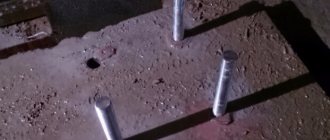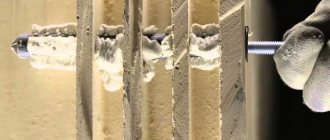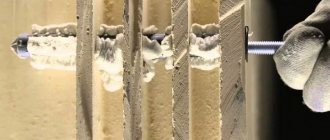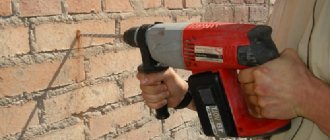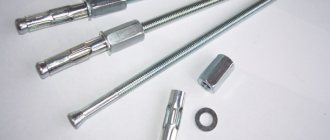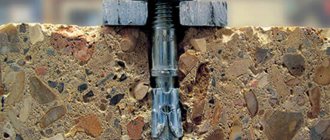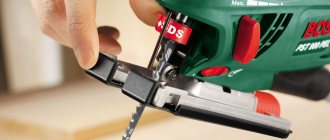At the design stage of critical objects and loaded structures, it is important to correctly determine the fastening elements that meet the requirements. Let's look at what a chemical anchor is and why it is considered the best solution compared to its metal counterparts. Let's get acquainted with the features of various modifications that can be found on modern trading platforms. Read to the end, and you will learn about the main rules for using liquid dowels and recommendations for choosing the right products.
Installing a mount on a hollow block using a chimanker Source stroyfora.ru
What is a chemical anchor?
Chemical anchor (liquid anchor, liquid dowel, adhesive anchor) is a two-component adhesive composition based on synthetic resins, which is a high-tech adhesive system. Externally, it is a tube of glue, in addition to which you need to purchase a special gun for a chemical anchor.
Chemical anchor gun
Initially, the new product was used mainly in the mining industry for the installation of structures and their fastening to loose rocks. Now anchors are successfully used in all areas of construction.
Important! The main difference between liquid anchors and traditional spacer elements is that chemicals provide a higher degree of fixation on fragile, unstable, and complex-structured materials.
Reliability of fastening is achieved through the inclusion of special components in the anchors - synthetic resins based on polyurethane, acrylic, polyester, epoxy oligomers. The exact proportions and names of the components are a trade secret of each manufacturer.
Approximate composition of chemical anchors, in addition to resins:
- fine-grained quartz sand;
- cement;
- hardener, etc.
Areas of use
Chemical anchors for concrete are most often used where there is a need for reliable and durable fixation of fasteners in porous, loose foundations. The viscous mass of glue penetrates into all the pores of foam concrete or aerated concrete, hollow brick, and during the hardening process it forms a strong and reliable connection of a metal bolt with the monolith of the structure with which it is connected.
Today, there is no alternative to a chemical anchor in cases where it is necessary to create a reliable fastening to hollow structures of objects of large weight and dimensions. Due to the fact that the glue does not expand during the hardening process and does not provoke bursting or wedging loads, fastening anchor bolts is effective in concrete and aerated concrete structures with a small cross-section of the material.
Chemical anchors are considered one of the most reliable types of fastening, and therefore they are used when installing balconies and bridges. Injection anchors are relevant when working with foam, slag concrete, cellular and slotted concrete where there are heavy loads: in the installation of fences, wall lanterns, supports, staircases, ceiling lamps, plumbing fixtures, canopies, suspended air conditioners, boilers, etc.
Fastening anchor bolts allows antennas, road billboards, advertising banners, and radio masts to withstand dynamic loads. It is also important that the fastening is not afraid of moisture and water, therefore it is actively used in hydraulic engineering and underwater structures - dams of various types, large and small swimming pools, large water parks, piers, etc.
Operating principle
Liquid anchor is quite easy to use. First, a hole is made in a concrete, brick or other surface, into which the adhesive mass is injected using a gun, and then a metal element is inserted - a rod, a pin, a corrugated reinforcing rod.
As a result, the chemical composition envelops the metal, filling even the smallest gaps between the turns of the thread and the pores of the base. The resins then harden, forming a dense monolith that securely holds the metal part inside the structure. The anchor connection can withstand the highest loads and in this respect is superior to conventional types of fasteners.
Advantages
Chemical anchor has the following advantages:
- possibility of using small cross-section parts;
- increased strength and reliability;
- wide scope of use of such fastening;
- Can be used for holes of various sizes;
- long service life;
- frost resistance;
- high tensile strength;
- resistance to external influences, including precipitation;
- resistance to corrosion, moisture, rotting;
- safety for human health;
- ease of use;
- high load-bearing capacity;
- tightness of blocking the hole after inserting the fastener.
Scope of application
A chemical anchor is most suitable for aerated concrete, stone, concrete, and brick (including hollow brick), although it can be used when working with a wide variety of materials.
Important! The use of anchors is especially important in situations where traditional fasteners and dowels cannot ensure a reliable connection. This applies to work with materials such as limestone, expanded clay concrete, cellular concrete, sandstone.
Dowel for aerated concrete
Areas of application of chemical anchor:
- house building – installation of roofing, balconies, building canopies, gazebos, gates;
- fixation of any steel elements;
- installation of handrails in tunnels and other work requiring electrical insulation;
- installation of ventilation systems on weak foundations;
- fastening of large-sized structures;
- arrangement of various underwater structures;
- installation of lifts at ski resorts, advertising elements, scaffolding;
- strengthening the foundation of buildings, connecting to the foundation;
- replacement of reinforcement in critical structures - bridges, stairs, ceilings, support columns, overpasses;
- installation of auxiliary equipment - plumbing, satellite dishes, lights.
Installation of metal structures
The metal fastener itself, suitable for working with a chemical anchor, can be made of stainless steel, carbon or galvanized steel. The composition can be used in conditions of any humidity, including under water.
Application area
Let us consider in more detail in which cases it is advisable to use chemical anchors. According to reviews from builders and recommendations from manufacturers, chemical anchors are most often used for:
- arrangement of highways and other road works related to the installation of signs, signs, advertising brochures, etc.;
- installation of ventilation systems on loose, porous and hollow foundations;
- reliable fixation of large metal structures;
- installation of massive advertising structures characterized by increased windage;
- restoration of various types of lifts;
- erection of scaffolding and sheathing;
- restoration of monuments;
- carrying out installation work in port areas and construction of various water bodies;
- installation of funiculars used at ski resorts;
- arrangement of electrical facilities.
In domestic conditions, chemical anchors may be required to attach heavy hanging furniture and interior items to an insufficiently strong base.
Types of anchors
Chemical anchors for concrete and other materials are sold in two forms: ampoules and cartridges.
Ampoule
Such anchors are produced for screws of a certain diameter. That is, each fastening point needs its own ampoule - a glass capsule with one-component content or two ampoules with an adhesive and a hardener.
The ampoule is inserted into the hole, after which a metal fastener is inserted, which breaks it. The glue flows out and sets, and the glass shards only help to strengthen the bond.
Capsule Type Chemical Anchor
Typically, ampoule anchors are used where particular precision of the joint is important. It is convenient to work with them, because there is no need to monitor the filling of the hole.
Important! This type of glue is not suitable for vertical structures made of cellular material. The composition will flow down before it hardens.
For the same reason, an ampoule chemical anchor is not suitable for bricks with holes: it is only suitable for solid building materials.
Cartridge
Cartridge anchors are also called injection or injection compounds. They are sold in the form of a volumetric cartridge with a pair of compartments that are filled with different compounds (resin and hardener).
Also on sale are products from two cartridges, the mass of which is mixed in a special gun. Most cartridge anchors are universal, but special compounds for concrete are also available.
Cartridge with two components of the composition
To perform fastening work, put a mixing spout on the cartridge, then insert it into the gun and perform all the necessary actions. This type of chemical anchor is suitable for use on hollow materials.
Before filling, a metal sleeve or plastic sleeve is inserted into the drilled hole so that the composition does not fill large voids in the base. The disadvantage of cartridge anchors is the risk of using too much.
Advice! To reduce consumption, mesh bushings are used, which are selected according to the size of the holes.
Fastener design
There are two types of anchorage depending on the location and method of applying the adhesive:
- The himanker is attached using an injection glue gun, which is loaded with two capsules of resin and hardener. Using piston pressure, their contents are squeezed out of the containers and mixed into a homogeneous mass in the nozzle of the gun using a spiral. The adhesive composition is fed into a drilled hole with an anchor rod fixed in it. The solution fills the entire volume of voids around the fasteners, including voids in brick or foam block.
- The glass capsule contains the active component of glue and hardener, separated by a partition. The mounting hole is drilled along the diameter of the capsule. The container is inserted into the prepared recess and a pin is inserted using a drill or hammer, which breaks the wall of the capsule. The adhesive and hardener are mixed to firmly secure the stud into the wall. Glass shards additionally reinforce the fastening.
Important! The capsule anchor is not used for vertical fastening in ceilings. The glue may leak and the connection will not form.
A chemical anchor consists of several parts that form a connection:
- Adhesive based on phenol-formaldehyde, polyurethane or polystyrene resin,
- The hardener accelerates the drying process of the adhesive composition,
- Fillers increase the strength and reliability of the connection, usually quartz sand or cement is used,
- A metal rod in the form of a bolt, pin, nail or piece of reinforcement.
Pros and cons of chemical anchors
The building composition has many positive characteristics:
- absolute tightness of the attachment point;
- absence of tensile loads, which is especially important for concrete foundations;
- versatility, ability to operate in various areas of construction and repair, suitability for any materials;
- ease of use, no need for special knowledge and skills;
- the highest strength after final hardening - an indicator greater than that of conventional metal anchors and dowels with a sleeve;
- significant load-bearing capacity, tolerance of serious mechanical loads, regardless of the type of base material;
- resistance to chemicals, corrosion, and negative atmospheric factors;
- Possibility of use at high humidity, under water;
- long service life - up to 50 years;
- absence of toxic compounds (not in all formulations), suitability for indoor use;
- approximate equality of the coefficients of thermal expansion of the composition and most building foundations, which reduces the risk of internal stresses during temperature fluctuations.
Advantages of a chemical anchor over a conventional one
The disadvantages of chemical anchors include a rather long time until complete polymerization and readiness to absorb maximum loads. So, at a temperature of about +50 degrees this time will be 5-7 hours, and at ordinary room temperatures it will be much longer.
During the cold season, the curing process may stop altogether. The shelf life of such formulations is limited - it makes no sense to use them 12 months after production, even if the packaging was sealed.
After opening, you will have to use the product in one go, so for the sake of a couple of fastenings it is better to buy ampoule anchors. The price for this type of fastener is quite high, which repels some buyers.
Advantages and disadvantages
To understand what a chemical anchor for concrete is and where it can be useful (and where it will become the only possible method of fastening), it is necessary to study the main pros and cons of this type of connection.
Main advantages of chemical anchor:
- Maximum connection strength
- Safety and environmental friendliness (provided that non-toxic components are used in the production of the adhesive composition), no unpleasant odor
- Wide scope of use - on land and in water, inside and outside buildings, in dense materials and porous
- Does not provoke a tensile load, does not expand, does not produce expansion stress, so the chemical anchor can be used directly at the edge of the structure
- Simple, quick and easy installation – regardless of whether the chemical anchor is used in an ampoule or cartridge
- Ability to withstand severe tensile stresses
- Tightness - complete sealing of the hole where the anchor and bolt are inserted
- Service life is 50 years or more
- Resistance to negative atmospheric factors, corrosive, chemical, physical influences
- Resistance to shock and vibration loads
- Wide range of temperatures at which the anchor can be used - some manufacturers offer fasteners for installation at -18 and up to +40C
- Ability to use any fastener - smooth and grooved reinforcing bars, threaded bolts, bushings, pins and other metal elements
Among the disadvantages of chemical anchors, it is worth noting their high cost, short shelf life in the package (regardless of whether it is open or closed), and the inability to use all brands in the cold. Most anchors harden in 20 minutes to 6 hours, but if the temperature drops below -5C, not every adhesive will be able to provide adequate strength. But, for example, some Hilti chemical anchors can be installed at a temperature of -23C.
Certain difficulties may arise when using cartridges that require filling the hole with a maximum of two-thirds of the composition. It is not easy for beginners to immediately learn how to determine the degree of filling of the hole, which is why the glue can come out. When using ampoules, such a disadvantage is not observed.
Selection rules
Before purchasing, it is important to carefully read the instructions for the chemical anchor. Manufacturers always indicate the types of structures and base materials to which this or that composition is suitable.
It is equally important to take into account the temperature conditions when working with the product, permissible loads on the structure, and possible humidity range. In addition, the anchor must meet the conditions of use according to the following indicators:
- types of fastening;
- fastener placement options;
- dimensions of metal rods;
- hole depth;
- curing speed;
- the need for a mesh sleeve.
For cartridge anchors, you will have to additionally buy a special dispenser gun, which is capable of mixing two components of the composition and dispensing them into a special spout. The price of such a product varies from 1300 to 7000 rubles.
Advice! Ampoule guns are cheaper - from 700 rubles, although you can use a regular drill instead.
How to choose a chemical anchor for aerated concrete, concrete and brick
Depending on the base material, different anchor mixtures are used. It is extremely important to ensure that the chemical composition of the anchor matches its characteristics and operating conditions. In order to accurately select a material, before purchasing it, you should carefully study the instructions included with it or located on the packaging. This document contains all the necessary information.
Most well-known manufacturers indicate in their recommendations the types of structures and materials for their manufacture, the optimal location of mounting holes and their sizes, the method of fastening, the range of humidity and temperature, as well as permissible loads for various bases. In addition, it is necessary to take into account possible limitations on operating conditions and the rate of polymerization of the mixture - this is of particular importance for chemical anchors with atmospheric polymerization.
Instructions for use
Even a beginner can use chemical anchors. The work includes drilling a hole, preparing it and filling it with compound, as well as screwing in metal bolts. Installation of fasteners is carried out at a temperature not lower than -5 degrees, or using special frost-resistant compounds.
Rules for drilling and preparing holes
When making holes for a chemical anchor and rod, you need to remember: the higher the load on the structure, the more accurate and better all work must be done. In any case, the hole diameter is made larger than the stud or reinforcement.
Drilling is carried out with a hammer drill with a drill of the required size. For cone-shaped holes, special drills with an oscillating jig are used; for drilling concrete walls, hollow drills are used.
Drill with oscillating jig
The finished hole is thoroughly cleaned of dust, preferably using air under pressure. It is best to use a carbon dioxide cylinder. If it is not available, a regular rubber bulb will do.
Important! After blowing, be sure to clean the hole with a brush and blow through again so that no dust remains inside - this is a very important condition for reliable adhesion of the composition to the base.
Sequence of work when gluing
The ampoule is installed directly into the hole of the structure, the pin is inserted using an electric drill or manually. In porous or hollow materials, a mesh sleeve is pre-fixed, which will allow the composition to be distributed more evenly.
The cartridges are placed in a gun with a guide spout, which will squeeze out the mass under pressure. If the length of the metal pin is more than 50 cm, it must be installed mechanically - using a special jig. The fasteners are left until completely hardened (the time is always indicated in the instructions).
Rules of application
Let's consider the sequence of steps for installing a chemical anchor:
- Drill a hole with a diameter exceeding the cross-sectional diameter of the inserted metal rod by 0.2 cm.
- Clean the hole from dust using a special brush.
- Insert the adhesive capsule along with the hardener into the hole or squeeze these components out of the tube.
- Insert the metal part of the fastener. As the glue hardens, it will form a reliable connection between the anchor and the surface.
How to prepare the material yourself
To save money, you can make your own chemical anchor based on epoxy resin. The finished composition is perfect for working with porous and dense materials.
The procedure for creating a tool is as follows:
- Combine ED-20 grade epoxy resin with DBP or DEG-1 plasticizer (up to 5-10% of the resin volume), mix well.
- Add gypsum or cement (also about 5-10%), knead until lumps disappear.
- Combine the composition with hardener UP-583 in a ratio of 1:8-1:10, mix again.
- The composition is fully developed within a minimum time.
- For polymerization, leave the chemical anchor for 12-24 hours.
Manufacturers
On the construction market, chemical anchors are presented mainly from imported manufacturers. Popular German brands are Fischer, TOX, the most popular Finnish brand is Sormat. It is also worth noting the products of the Swiss company Mungo.
A chemical anchor is an ideal material for fixing materials with a porous structure. If you want to attach a structure to a base made of foam concrete, hollow brick, expanded clay block, then a liquid dowel or anchor will be the best choice.
Manufacturers rating
Compositions from different manufacturers are available on the market. At the same time, the chemical anchors described below can boast of proven quality.
"Titanium"
The basis of the Titan EV-I composition is polyester resin. The dried mixture can work at temperatures up to +80 degrees, while complete polymerization at +25 degrees occurs in just 3 minutes. There is a winter version of Titan EV-W anchors on sale, which can be applied even at -18 degrees.
Sormat
The Finnish company Sormat produces anchors in cylinders and ampoules of various sizes, as well as disposable nozzles for their application. The adhesive is made on the basis of polyester resin and is intended for fastening medium-heavy structures.
BIT
This adhesive composition is used even at sub-zero temperatures (down to -18 degrees). Its base is epoxy acrylate resin.
Main characteristics of the material:
- capable of connecting even heavy concrete structures;
- Suitable for underwater use;
- has low viscosity;
- easy to use;
- does not have a pungent odor.
"Moment"
The chemical anchor “Moment Fastener CF-850” is used for fastening concrete, hollow and solid bricks, foam concrete, and holds heavy structures perfectly. It ensures rapid hardening and high reliability of fasteners and does not contain styrene.
Hilti
The composition of this brand, called Adhisive Capsule Anchor, is based on methacrylic and polyurethane resins, hardener and quartz sand, and is available in capsules and cartridges. It is successfully used even in areas of high seismic activity and under water.
Chemical anchors are an excellent solution for organizing quick and high-quality fastenings during the construction of various structures and structures. Despite the high price, this material has many advantages and makes the task easier for the master.
Working mechanism as the main advantage of a chemical anchor
Chemical anchor - for ease of understanding, this is a two-component powerful adhesive that can securely fix a metal element in any mineral base as reliably as possible. According to the European Technical Standards Organization, the substance can be called an “adhesive anchor”; among professional builders and self-taught craftsmen, the following phrases are common: “system of glued-in anchors”, “chemical dowel”, “liquid anchor”, “injection mass”.
Let us consider the mechanism of action of a fundamentally new type of fastening device.
The hole made in the base is filled with a chemical composition, then a metal element (threaded rod, fittings) is placed inside. Gradually the composition hardens, securing the rod. The resulting monolithic connection has the highest possible strength: certain types of structures, the installation of which is carried out with strict adherence to technology and the use of high-quality mixtures, can withstand multi-ton loads.
Chemical anchors are widely used for fixing fastening elements mainly made of brick, concrete, wood, stone, metal, and are in demand in the construction of ultra-stable load-bearing structures (building canopies, balconies or bridges). Fixation with a chemical anchor is much stronger than with a conventional (mechanical) one: the frozen injection mass can withstand two and a half times the load.
Let us note the main advantages of chemical anchors
:
· prevalence of use and the ability to create reliable fastenings even in low-strength bases, such as gas and foam concrete, some types of hollow bricks;
· increased strength, many times superior to mechanical anchors;
· resistance to the aggressive and destructive effects of water or alkalis, which makes it possible to use innovative material in a humid environment;
· absolute tightness of seams;
· the inner surface of the holes is not subject to pressure (compared to expansion anchor fasteners), due to which the chemical anchor is suitable for fixing parapets and railings;
· durability of fastenings (service life - more than half a century).
Sequence of use
There are a number of rules and algorithms that will help achieve maximum strength and durability of the connection.
- You need to drill a hole that will be 2 mm larger than the cross-section of the bolt, reinforcement or rod used for fastening.
- The inside of the hole must be cleaned using a brush, vacuum cleaner or water.
- The composition is squeezed inside or a capsule is installed. When extruding, the volume of the composition should not exceed the volume of the hole itself.
- The required fastener is inserted into the hole. You need to wait for final hardening. Remaining adhesive can be removed mechanically.
After installation, the element must be tightly secured in the hole. Wobbling or rotation around its axis is excluded. When installation is carried out at low temperatures, it is recommended to preheat the material using a torch or hair dryer.
© All rights reserved | 2012 - 2019
Catalog
Soudal professional product line
Soudal household product line
Injection anchors
Manufacturers use styrene for mixing. The setting speed directly depends on the surfaces and air temperature. A hole is first prepared in the surface. Everything inside is cleaned well. The adhesive composition is placed inside where the fastening component is installed.
The composition penetrates deeply into all irregularities or crevices, filling the void. The glue hardens, covering any imperfections. This method is ideal for hollow building materials. Using a liquid chemical anchor, it reliably bonds to the underlying surface, eliminating premature wear or breakage as a result of exposure to loads of any type.
Ampoule anchors
These instruments are presented in a glass ampoule. A working composition in the form of resin is installed inside, which begins to harden after contact with air. The base is pre-drilled. An anchor in the form of an ampoule containing resin is installed into the finished device.
When the ampoule is inside, a rod, anchor or steel reinforcement is screwed into the hole. Mechanical contact with the ampoule leads to its destruction, which frees up the composition for further gluing of the surface and the working tool. Glass in this situation acts as additional reinforcement.
